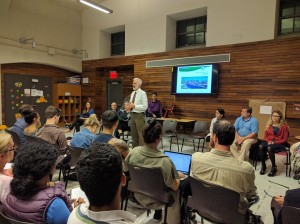Mr. Superfund
By Wanda Ayala
In the comic books we have fictional superheroes like Batman and Superman whose mission is to safeguard the people of Gotham or Metropolis, communities that are similar to where many of us work or live. Here, in our Region 2 offices, we have our own hero. His name is Walter Mugdan, head of our Emergency and Remedial Response Division, and I call him “Mr. Superfund.” He is part of a great team of people dedicated to public service, many of whom started when the Agency was young (so were they!) as part of a movement that was taking place in our society to ensure that we safeguarded our people and our nation from the consequences of pollution. Mr. Superfund knows and explains to others that EPA is not just about consolidating authority over environmental issues, but that we work to establish standards for industry and life that directly and indirectly affect public health and our overall well-being. Having an EPA means the concerns over the air that we breathe, the water that we drink and the ground that we walk on are reduced because our environment is being protected and maintained.
About the Author: Wanda Ayala is a community involvement coordinator in New York City.



